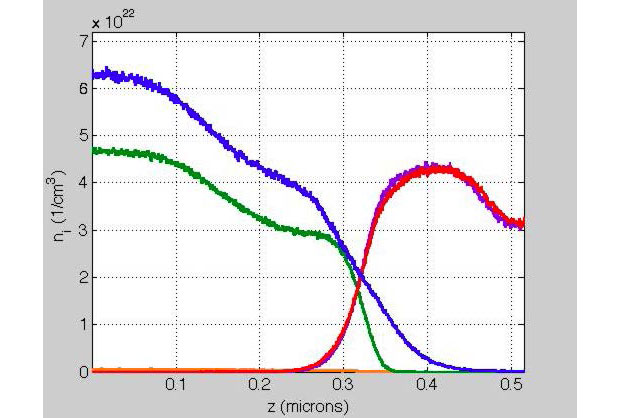Robert Rudd (15-ERD-052)
Project Description
We plan to develop a new capability to calculate thermodynamic and transport properties of asymmetric plasma mixtures—plasmas with two or more components differing significantly in charge and mass—in the presence of strong gradients. Inertial Confinement Fusion with ablator materials mixing into the deuterium–tritium plasma is such an example. The molecular dynamics plasma simulation code ddcMD developed in the Cimarron project (which was dedicated to the prediction and measurement of properties of dense, highly collisional, and strongly coupled plasmas) will form the basis of this capability. Specifically, we will deliver a high-fidelity description of plasmas, including cases where there is strong ion–ion coupling for at least one component. We will develop new molecular dynamics techniques for transport calculations including accurate equations of state of asymmetric plasma mixtures, even in the presence of strong gradients such as sharp interfaces. Our initial simulations will focus on an interface at rest, and then proceed to simulations of an accelerated interface including diffusion brought about by pressure gradients and the Rayleigh–Taylor hydrodynamic instability.
On successfully completing this project, we will have developed the capability to conduct plasma simulations with strong gradients, including those in the strongly coupled regime. We expect to develop simulations of diffusion in asymmetric plasmas with strong gradients by properly treating the plasma equation-of-state (not making an ideal gas approximation) as well as the screening and electric fields associated with variations in electron density (see figure). We will have calculated the reflecting power of the interface relevant to questions about Knudsen molecular diffusion effects, and demonstrated the performance of the code in massively parallel simulations on Livermore supercomputers.
Mission Relevance
The new capability will address Livermore's strategic need to predict transport processes in plasma and warm dense matter systems that are heterogeneous, such as at an interface. The new capability will be most relevant to the Laboratory's strategic focus area in stockpile stewardship science, in which new approaches are sought to model plasmas to better understand boost physics in weapons. In addition, this project supports core competencies in high-performance computing, simulation, and data science as well as high-energy-density science. The project also has applications to Department of Energy Office of Science strategy, which specifically identifies nonequilibrium plasma properties as a priority research area.
FY16 Accomplishments and Results
In FY16 we have (1) improved mixed-plasma capabilities in ddcMD, including ionization levels and the equation-of-state in inhomogeneous mixed-plasma systems such as those found at interfaces; (2) begun developing a better model of the electronic pressure contribution; (3) continued working on, and are on track to complete, the molecular dynamics interface simulations with a stationary interface; (4) developed the code and capability for simulations of barodiffusion, which is diffusion caused by a pressure gradient; (5) observed species separation in shock simulations; (6) compared continuum simulations and calculated additional transport coefficients; and (7) began conducting the first calculations of the ionic albedo for deuterium–tritium and ablator interfaces.
Publications and Presentations
- Haxhimali, T., et al., "Shear viscosity for dense plasmas by equilibrium molecular dynamics in asymmetric Yukawa ionic mixtures." Phys. Rev. E. 92, 053110 (2015). LLNL-JRNL-674655. http://dx.doi.org/10.1103/PhysRevE.92.053110
- Haxhimali, T., et al., Study of shear viscosity for dense plasmas by equilibrium molecular dynamics in asymmetric Yukawa ionic mixtures. 57th Ann. Mtg. APS Division of Plasma Physics, Savannah, GA, Nov. 16–20, 2015. LLNL-ABS-675170.
- Rudd, R. E., et al., Plasma Frontiers: Extreme states of matter and plasmas. (2016). LLNL-MI-691637.
- Rudd, R. E., et al., Species diffusion in plasma mixtures. American Physical Society Division of Plasma Physics Mtg., San Jose, CA, Oct. 31–Nov. 4, 2016. LLNL-ABS-697256.






